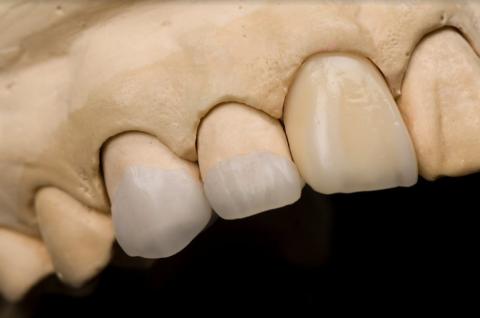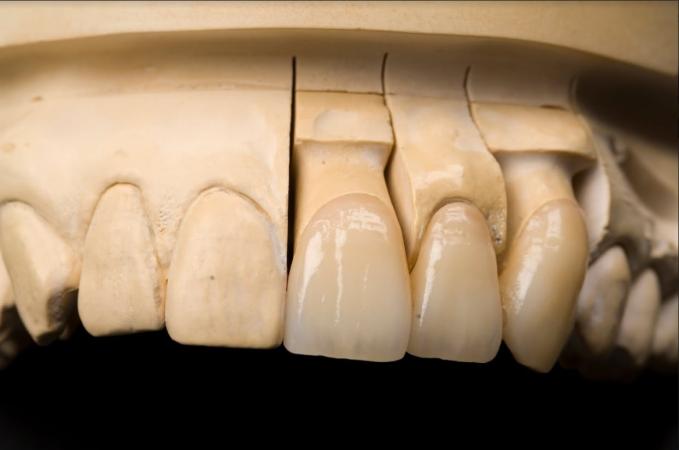- For the exclusive use of professional dentists.
- (+34) 973 271 434
- info@arpadental.com
For the exclusive use of professional dentists.
Fixed dental prosthesis
Restorations with the precision and aesthetics that your patients deserve
At ARPA Dental Laboratory we count on our equipment and our highly qualified technical team who are constantly training to respond to the needs of clinicians relying on our trusted laboratory and specialising in the different types of fixed dental prosthetic restorations.
Our Fixed Dental Prosthesis section covers:
- Fixed Dental Prostheses with metal
- Fixed Dental Prostheses without metal
- Aesthetic Fixed Dental Prostheses, for minimally invasive restorative dental procedures, with the sole purpose of correcting aesthetic problems.

-
Description

Fixed dental prosthesis includes dental restorations that are mounted to the patient's mouth.
For this, the dentist cuts or files the teeth that will serve as a support for the fixed Dental Prosthesis, called abutment teeth.
The clinician takes the dental records (with an intraoral scanner or an impression tray) and sends the impression to our Dental Laboratory, for the manufacture of the fixed dental prosthesis with Dental CAD/CAM technology and with the personalised finish of each fixed dental prosthesis.
Once the necessary tests have been carried out, and after achieving the desired objectives, the dentist will attach the dental prosthesis into the mouth, without it being able to be removed by the patient .
THESE DENTAL PROSTHESES CAN BE CROWNS, BRIDGES, VENEERS OR INLAYS
-
Types of Fixed Dental Prosthetic Restorations

- CROWN: An individual restoration for a specific fixed tooth.
- BRIDGE: A type of fixed dental prosthesis that replaces the edentation of one or more teeth, called pontic teeth, supported by the neighbouring or abutment teeth.
- VENEERS: Most aesthetically pleasing and minimally invasive restoration of a part of the tooth.
- INLAYS: Restorations that base their retention at the expense of both the internal and external walls of the abutment tooth.
- PROVISIONALS: Provisional dental prostheses.
-
Materials

- SINTERED COBALT CHROMIUM: A hard but flexible and resistant metal. Highly accepted and used. Minimum thickness of 0.4mm. It can be coated with both ceromer or ceramic.
- ZIRCONIUM: A biocompatible material. Like teeth, It is white or yellow in colour, therefore more aesthetic. Very hard. Minimum thickness 0.5mm. It can be coated with ceromer or with ceramic. There is also the possibility of doing it in monolithic zirconium without coating.
- PEEK: A new material in the sector. Very biocompatible. Maximum hardness, flexible and very light. Aesthetic colour. Always coated with ceromer.
- LITHIUM DISILICATE: For restorations of high aesthetic demand. This material can be used in the dental laboratory with both Dental CAD/CAM technology (E.-Max CAD) as well as with injection technology (E-Max Press). Minimum thickness 0.3. It can be coated with ceramic or a monolithic lithium disilicate staining. Inform the laboratory about the tonality of the tooth stump and our dental technicians will select the lithium disilicate material at the required opacity in order to give the most natural and aesthetic pleasing appearance.
- CERAMIC (feldspathic veneers): For restorations aimed at masking the visible surface of the tooth with the sole purpose of correcting aesthetic problems only with ceramic and with minimally invasive cuts.
- CEROMER: A hybrid material between resin and ceramic which offers a good aesthetic result and a great clinical behaviour. Very high physical-mechanical properties. It has good characteristics in terms of camouflage, translucency, opacity and biocompatibility. High resilience characteristics.
- PMMA for provisionals: Milled in our dental laboratory using Dental CAD/CAM technology. It is a non-polymer aesthetic material for fixed dental prosthesis for a limited time, awaiting the placement of the final dental prosthesis.
-
Technical Characteristics
All of our production of structures for fixed dental prostheses is made with virtual design programs and processed by milling or sintering (with Dental CAD/CAM technology). This allows us to:
- Give excellent adjustment, precision and passivity to our work on fixed dental prostheses.
- Use a wide variety of materials depending on the needs of the patient and the clinician.
Once the structure is produced and after the clinical check-up, the laboratory proceeds to coat the structure with aesthetic material that may be either ceramic or ceromer, placing value on our high biofunctional, aesthetic and natural work with our glazing, staining and final finish techniques.
Advantages of our dental prostheses
WHAT MAKES US DIFFERENT?

High aesthetic natural finishes

Dental CAD/CAM design and production

Faster and more accurate processing
Fixed Dental Prosthesis works
Other treatments
Find out more about our prosthetic solutions
Subscribe to receive the latest news
- Dr. Combelles, 7 - altell 25003 Lleida
From Monday to Thursday: from 7:00 a.m. to 7:00 p.m.
Friday: from 7:00 a.m. to 3:00 p.m. - (+34) 973 271 434
- info@arpadental.com

Copyright © 2018 - 2024
Web project developed by ACTIUM Digital

